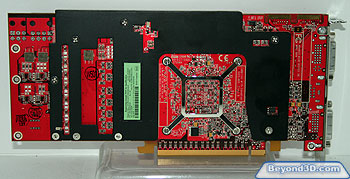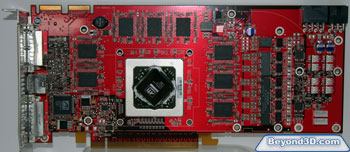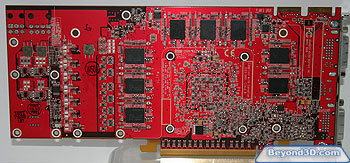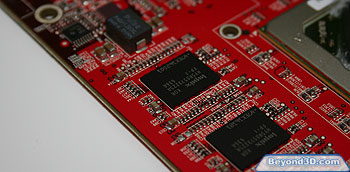The Radeon HD 2900 XT Reference Board
The only R600-based launch product is Radeon HD 2900 XT. To signal the intent of the products in terms of how they're able to process screen pixels, be that in motion video or real-time 3D graphics, AMD are dropping the X from the product family in place of HD. The familiar XT, XTX (maybe) and PRO monikers for inter-family designation will stay, however. Radeon HD 2900 XT sports two clock profiles, the 3D one seeing R600 clocked at 742MHz (the chip has a single master clock domain, across many slightly asynchronous subdomains), with 512MiB of GDDR3 memory clocked at 825MHz. The 2D profile sees things drop to 507MHz for the chip, with the memory run at 514MHz. Windowed applications are run in the 2D clock profile.
The table above will start to give some of the story away if you're willing to take the base clock and do some basic arithmetic. By virtue of the 512-bit external memory bus and Hynix HY5RS573225A FP-1 DRAM devices clocked at 825MHz (1.65GHz effective rate), HD 2900 XT has a peak theoretical bandwidth of 105.6GB/sec. One hundred and five point six, for those still blinking at the figure in numerical form. And while AMD aren't the first company to deliver a single board consumer solution with a peak bandwidth higher than 100GB/sec, given NVIDIA's soft launch of GeForce 8800 Ultra and its 103.6GB/sec peak via a 384-bit bus, they're definitely the first to try a 512-bit external bus on a consumer product.
Retail editions of the board are barely larger than AMD's outgoing Radeon X1950 XTX, PCB size wise, although the cooler is a good bit beefier. While it looks like your average double slot cooler for a high end board, replete with blower fan and rear exit for the exchanged heat, the mass of the sink attached to the board and the components it's cooling is significant. In fact, the board is the heaviest 'reference' hardware yet created, with reference used to define the cooler that the IHV officially specifies.
It's a somewhat sad fact, for AMD and the consumer, that TSMC's 80HS process has pretty horrible static power leakage properties. Given the process properties, the die area, clocks for GPU and mem, and the memories themselves, it's no honest surprise to see the fastest launch board based on R600 coming with such a cooler. It's also no real surprise to see it come with a pair of external power input connectors, and one of those is the new 8-pin variant as well. That version of the connector gives the board another +12V input source at just over 6A max current.
The board doesn't require you fill that connector block up with power-giving pins, though, since it runs happily with a regular pair of 6-pin inputs. Look closely and you'll see the 8-pin block holds the 6-pin block, and there's only one orientation that can make it happen, so you don't connect the wrong pins and have things go horribly wrong.
A pair of dual-link DVI connectors dominates the backplane space that the first slot occupies, with the grille for the heat output dominating the second. The DVI ports (although it's unclear if it's just one of them or both) support HDMI output for video and audio via a supplied active convertor. It appears that audio is either muxed into the video bitstream pushed out over the pins, or the spare pins on the dual-link connector (the version of HDMI that the hardware supports is analogous to single-link DVI for the video portion) are used for that, but it's an implementation detail at best.
Physicals
In terms of the board's physical properties when being used in anger, we've run our test sample just fine using a PSU that provides only 6-pin connectors. Calibrating against other boards on the same test platform, we estimate (because we're not 100% certain about other board's peak power either) peak load power from the board, at least using our load condition of 3DMark05's GT3 @ 1920x1200 w/4xAA/16xAF, of less than 200W at stock frequencies. We haven't tried overclocking enough to be sure of a peak power draw using the Overdrive feature.
Using AMD's GPU overclocking tool which is able to read the GPU's thermal diode, load temperatures for the GPU approach 90°C with our sample. Under the load condition generating that heat, the fan speed is such that board volume is higher than any of the board boards on test, and that the pitch of the noise is annoyingly high with a whistling property to it, at least in our test system and to our ears. Added to that, the speed steppings of the fan make pitch changes very noticeable, and the board constantly alters fan speed in our test system, even just drawing the (admittedly Vista Aero Glass) desktop. So there's no static 2D fan speed that we can see, and the overall noise profile of the cooling solution is subjectively much worse than Radeon X1950 XTX, NVIDIA GeForce 8800 GTX or GeForce 8800 GTS.
So while the board's form factor is pleasing in the face of NVIDIA's highest-end products, simply because it's not as long and will therefore fit into more cases than its competitor, the cooler is a disappointment in terms of noise. It certainly seems effective when dealing with heat, though, and we're sure that was AMD's primary concern when engineering it. It's possible that things can get better for the product here without any hardware changes, via software. The fan's got more variable speed control than the driver seems to make use of, and a more gradual stepping function to change fan speed based on GPU load and temperature can likely be introduced. Here's hoping!
Time to check out the test system that we used for our architecture and performance investigations.






